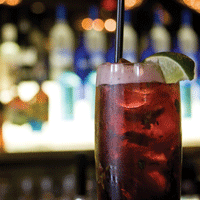European tradition has shaped the modern Canadian restaurant but not when it comes to pre-dinner drinks
You’ve just been seated in a hot new restaurant and before you even get your hands on the dinner menu it’s decision time already. Do you want to go bold and adventurous or will a simple classic suffice? Do you fancy something indigenous to the region or from a faraway locale? High-end or inexpensive? Wine, beer or cocktail? With so many options available, choosing an aperitif can be maddening.
Traditionally, aperitifs were enjoyed before dinner to prepare your palate for a meal. The word is derived from the Latin root, aprire, or to open, and the practice is ingrained in cultures across Europe. The citizens of Rome, ahem, do as the Romans do. They drink Campari or Cinzano before dinner — straight up or diluted with a splash of mineral water — or something bubbly like Prosecco. Parisians tuck into tipples like Dubonnet, Pernod and Saint-Raphael, or have a glass of champagne before eating. Lively Londoners down gin martinis — some shaken, some stirred. Greeks guzzle ouzo; Spaniards, cava. All are effective at whetting the appetite and can increase your enjoyment of a meal.
But what happens in Vancouver, Montreal and Toronto? Is the average Canadian ordering European-style aperitifs? “The idea of a traditional aperitif isn’t that prevalent in Canada,” says Geoff Boyd, in-house sommelier for Vancouver-based Joey Restaurant Group. With 18 locations in Western Canada and the northwestern U.S., the upscale casual-dining chain expanded into the Toronto market in September. “In Europe, dining is more stringent in the way they course their meals. The number of requests we get for Campari on the rocks or Dubonnet is a non-factor, to the point where we don’t even carry some of those spirits.”
Boyd says that before eating, the typical Joey customer quaffs everything from Prosecco and sparkling wine, to white wine, beers like Stella Artois and a selection of slush-infused cocktails. In fact, Canadian bartenders use most traditional aperitif spirits to mix drinks. “I don’t think Canadians are hardwired to sit down and have Dubonnet or Campari to get their appetite going,” says Boyd. “Those are such fringe flavours anyway.”
Montreal is known as Canada’s most sophisticated, gregarious, European-influenced city; surely there the traditional aperitif is alive and well. Not so, says Lianne Castravelli, sommelier at The Fairmont Queen Elizabeth hotel. The most common aperitif she serves is champagne or sparkling wine. “Cinzano or Saint-Raphael is rarely ordered. When it is, it’s usually by someone in their 70s visiting from Europe.”
Oddly, though she doesn’t sell much of it at the hotel, the 30-year-old Castravelli enjoys a traditional aperitif before dinner. “My grandfather is Italian and we have a habit of drinking Saint-Raphael, Martini & Rossi or a sweet vermouth of some kind before a meal. It’s not a large drink, the alcohol content isn’t high and the sugar isn’t as present as it is in a cocktail. It’s great for whetting the appetite.”
What she does recommend before dinner is VQA sparkling wine. “If I’m picking a Mumm or sparkling, I go for Sumac Ridge’s Stellar’s Jay,” Castravelli says. “When it maturates, it comes into contact with the grapeskin so it has a slightly grayish/pinkish hue. It’s a fantastic sparkling wine.” For red wine she likes Gamay or Pinot Noir varietals, but not ones that carry a lot of weight, and she might even serve them chilled. With beer, she says Unibroue’s Blanche de Chambly is always a good call.
Castravelli is also fond of Quebec-made sparkling cider and includes it as an early pairing in the restaurant’s regionally inspired tasting menus. “When we do our tasting menu, we focus on Quebec product, so I serve something like Jodoin’s white sparkling cider as a starter. I’d also work with our chef to see if we can do an amuse with duck confit to go with it.”
At Chambar in Vancouver, the wine list is thoughtfully cobbled together with Old and New World selections, but many patrons opt for innovative cocktails instead. Yet as an aperitif, they work — bar manager Wendy McGuinness whips them up with classic French spirits like Lillet and Chartreuse. The Fragaria ($12) combines muddled local strawberries and earl grey-infused bourbon with a splash of Chartreuse and a dash of cinnamon, and gets a good shake before being served straight up. The Diago Tito ($11) pairs fresh ginger and pineapple shaken with pisco, Lillet blonde and finished with Campari. And the La Fee Rose ($12) mixes pressed watermelon with Danfield’s whisky and a splash of absinthe (see sidebar).
“We’ve recognized that people in Vancouver want to have a cocktail to get going before they move into their evening meal, when it’s my turn to suggest wine pairings,” says Mike Mitchell, general manager and sommelier at Chambar. “So you actually see the traditional aperitif come across in our cocktail list. These are alcohols that are going to wake up your palate, but we’ve done it in a sneaky way. The drinks look and taste amazing. They’re more approachable and they get that palate prepared for dinner.”
Besides, most diners are indecisive. Some treat the ordering process like a fantasy football draft — with way too many options, they fall back on old favourites. “It’s almost as if it’s been turned on its head,” Joey’s Boyd says. “Our tradition is more about getting in and having a beer, a glass of white wine or a cocktail, and then making an educated drinks choice once you’ve had time to decide what you’re having for dinner.”
Taylor Thompson, sommelier at Reds Bistro and Wine Bar in Toronto, says only five or 10 per cent of his customers opt for traditional aperitifs. “What’s more common is someone starting with a light refreshing white wine. And if you look at the term aperitif, it doesn’t have to be hard alcohol. Even sparkling water with a nice level of sodium and sharp bubbles is a good aperitif.” Think San Pellegrino with a slice of lemon.
One of the most approachable sommeliers in Toronto, Thompson also knows booze. “What I’m usually looking for is something that has a good level of acidity, which will really start opening up the palate. It gets the mouth watering; it actually makes you hungry.” For whites, he recommends something crisp like sparkling wine or a Sauvignon Blanc, and suggests going with Old World producers. “The New World wines tend to have a lot of character on their own, and maybe too much fruit to be had as an aperitif,” he cautions. For a favourite cocktail, Thompson takes inspiration from the New World hotbed of Chile and recommends a pisco sour. “With its lime juice base, it has the acidity that will clean up the palate. It also has a bit of sugar that entices the palate as well.”
What he doesn’t recommend is a big chewy red. “People often order an old Napa Cab before dinner; that’s when classical dining gets pushed aside. Not only do these huge red wines ruin your palate for delicate food, they also fill you up.”
OK, but what if a customer is adamant on drinking a pint of Guinness or a big glass of 1997 Stag’s Leap Cabernet before they dine. “You give them what they want,” says Boyd.
Sage advice. Let them relax with an old standby and they’ll likely be more responsive to one of your suggestions later on. Either way, the register rings.




















